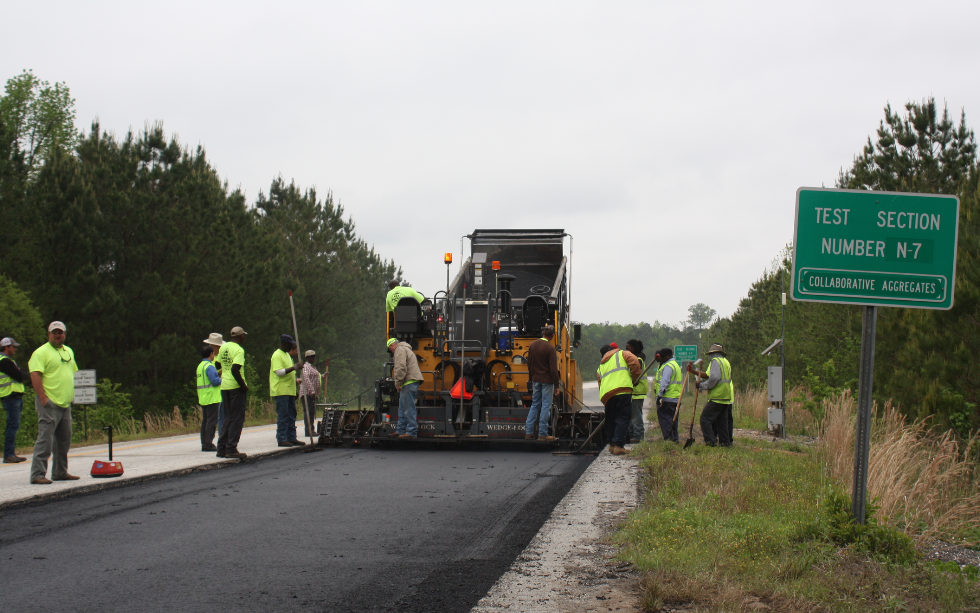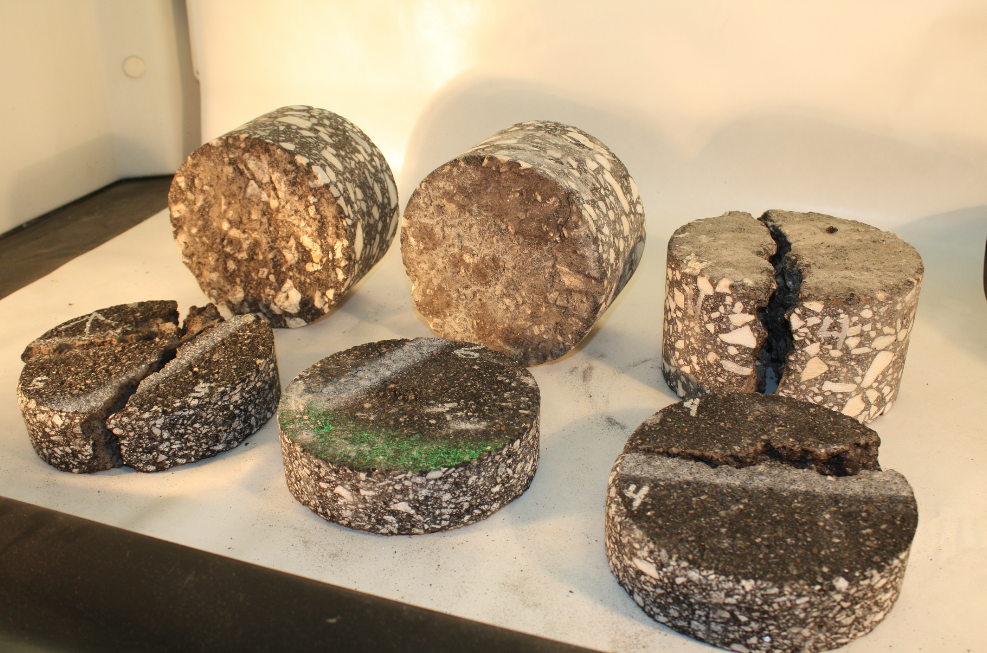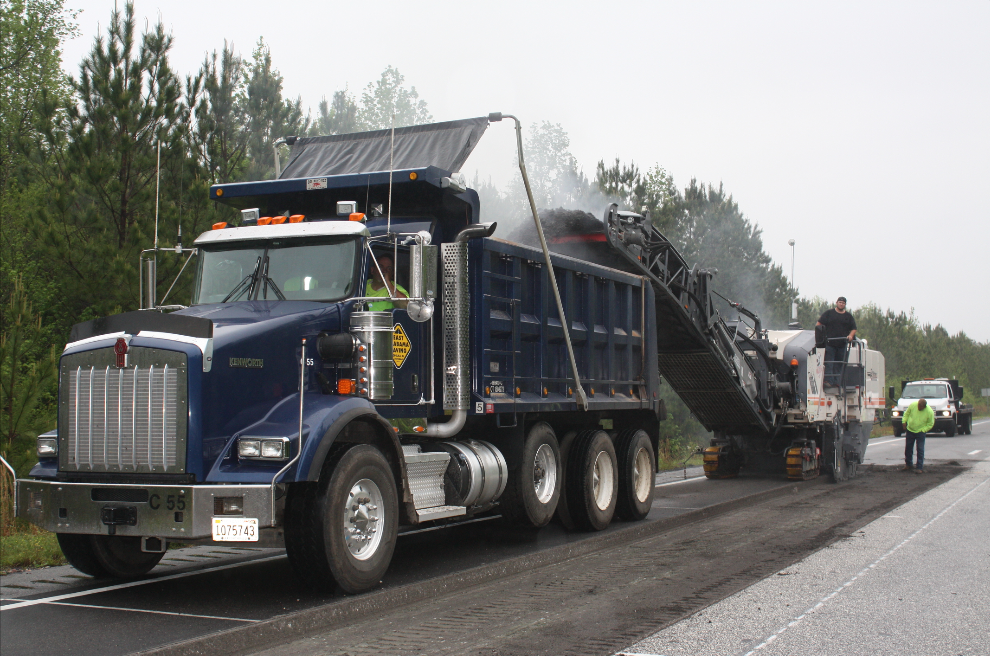NCAT Forensics: Section N7 Contributes to Silo Storage Recs, RAP Content Suggestions
BY Paul Fournier

Researchers at the National Center for Asphalt Technology (NCAT) at Auburn University in Alabama study failed as well as successful experimental sections on their pavement test track. The latest three-year research cycle at the track includes a special focus group of pavement sections they hope will fail. The reason: they learn as much from evaluating failed sections as they do from successful sections, according to Dr. Raymond “Buzz” Powell, NCAT assistant director and test track manager.
Powell and his staff, including Jason Nelson, operate the 1.7-mile oval track that uses accelerated performance testing to simulate the effect on pavements up to 10 million equivalent single axle loads (ESALs) in each research cycle. Research at the track is also conducted by other researchers at NCAT with Dr. Randy West, NCAT director, taking overall responsibility for the research facility.
Case Study: A Puzzling Non-Performance
One pavement test section’s recent failure illustrates NCAT’s exercise. For its sixth research cycle, NCAT had decided to form a Cracking Group (CG) consisting of seven discrete experimental pavements, sponsored by nine state agencies and the Federal Highway Administration. The purpose of the CG is to test the performance of wearing courses with various levels of resistance to cracking facilitated by varying binder modification, field density, and percentages of recycled asphalt pavement (RAP) and recycled asphalt shingles (RAS). This research is part of the industry effort to develop a performance-based spec to effectively use recycled materials without affecting a pavement’s resistance to cracking.
CG sections were designed with essentially the same pavement structure with dense graded, structural composition on top of a 6-inch crushed granite base, but surface mixes differ. Researchers’ main goal was to be able to identify laboratory tests that predict cracking differences observed on the test track in mixes with various levels of resistance to cracking and containing varying recycled asphalt product contents.
The seven CG sections were constructed in late July and early August of 2015, all consisting of a 2.25-inch asphalt base layer, 2.25-inch intermediate layer, and a 1.5-inch surface course. The base layer and intermediate layer of all CG sections contained highly modified asphalt (HiMA) binder.
There is an eighth test section not included in the CG study, designated N7, which is nevertheless playing an important role in this research. N7 is sponsored by Collaborative Aggregates LLC, an affiliate of Warner Babcock Institute for Green Chemistry (WBI), based in Wilmington, Massachusetts. The company is using the section—which is a dense-graded, high-recycled asphalt content, surface mix inlay—as part of its own applied research to document the performance of its newly commercialized Delta S asphalt rejuvenator product. Delta S is a plant-based, liquid specialty chemical formulated by WBI that is designed to work with recycled materials to minimize asphalt pavement cracking. The research is managed by Drs. Nam Tran and Powell.
Powell noted that they intended to compare the performance of stand-alone N7 section containing the asphalt rejuvenator with CG Section N8, which is similar in design and construction but doesn’t contain a rejuvenator.
N7 and N8 had identical surface course structure, i.e., each contained 20 percent RAP and 5 percent RAS. The asphalt binder of N8 and the six other CG sections contained a combination warm mix and anti-stripping agent, but the N7 surface mix only contained Delta S rejuvenator.
First Failure
Truck trafficking began in October 2015, and for almost three months none of the seven CG sections nor N7 exhibited pavement stress. In late January 2016, however, things changed.
NCAT staff noticed cracking in the wheel path of N7. In March, they took full-depth cores of the entire 6-inch pavement structure in between the wheel paths in an uncracked area to determine bond strength between layers as part of the forensic investigation of the pavement failure.
Surprisingly, all three cores were found to be de-bonded, i.e., the wearing course is delaminated from the underlying layers. NCAT allowed traffic to continue for a short time but suspended it when existing cracks grew larger and new ones appeared. Three additional cores cut on transverse cracks indicated that the intermediate and base layers had been compromised as a result of the de-bonding, meaning the underlying layers had also cracked.
A strong bond between pavement layers is a critical component in long-lasting asphalt pavements. As a vehicle moves over a pavement, horizontal forces between tires and the pavement surface induce shear stresses at the interface between pavement layers. If the induced shear stress exceeds the bond strength at an interface, de-bonding may occur. In delaminated areas, the pavement structure no longer acts as a monolithic unit, so the critical tensile strain occurs at the de-bonded interface between layers rather than at the bottom of the asphalt pavement. And this leads to premature failure.
As the forensic investigation continued, the evidence suggested that the cracking problem with N7 was due to de-bonding between the surface course and intermediate layer. NCAT staff suspected the N7 surface mix de-bonded and the CG Section N8 surface mix did not because the N7 mix was slightly leaner (even though volumetrics compared within allowable tolerances).
What’s more, visual observations of the layer interface, which appeared to be relatively dry, seemed to support the hypothesis that the asphalt tack coat had migrated from the interface into the surface mix. This meant there wasn’t enough asphalt between layers to develop adequate bonding. However, this theory was brought into question when further laboratory testing of compacted slabs indicated that low bond strengths were not the result of tack material.

These core samples are from the original failed N7 pavement section.
First Fix
NCAT researchers continued their forensics pursuit with a different approach because evidence indicated that cracking was full-depth. To fix this, they had the entire six inches of N7 pavement structure removed and rebuilt because they felt it was important to replace both the base and intermediate layers. HiMA was used for both mixes similar to the seven CG sections that contained HiMA in their base and intermediate layers. Furthermore, the thickness, aggregate gradation and asphalt binder grade of intermediate and surface layers were the same as that of the original N7, with the surface mix again containing 20 percent RAP and 5 percent RAS.
This repair took place during the week of April 11. Within just a few days of the repair, N7 surface pavement failed again, exhibiting cracking and shoving that was once more attributed to de-bonding.
This case had become an intriguing challenge for researchers. They suspended traffic on N7 on April 16 when truck drivers first reported seeing the slip, and launched a second forensic investigation. This time they cut six additional cores from N7 located from just on the outside of the edge line to avoid damaging the base and intermediate layers, which would remain in place when the final N7 surface was paved. Three of these cores underwent bond strength testing in both layer interfaces (i.e., between the surface and intermediate layers, and between the intermediate and base layers). The remaining three were subjected to indirect tensile testing (IDT) and tensile strength ratio (TSR) determination. Bond strengths were found to be unacceptably low in N7 when compared to CG Section N8 and also when compared to minimum recommended values. More importantly, IDT results on field cores from N7 were much lower than those from CG Section N8 while previous IDT results on laboratory specimens were similar for the two mixes. Further laboratory testing was conducted to simulate silo storage time at 0.2 and 4 hours. This testing revealed the significant effect of aging in silo on IDT results of N7 mix, which had been minimal in both the original construction and the first rebuild of N7.
Based on the entire body of forensic evidence, Powell and his team of researchers agreed on a notably simple solution to the N7 de-bonding puzzle. They would allow longer silo storage time for the blending of asphalt rejuvenator with RAS binder.
A Simple Solution for a Final Fix
“It appears the desired interaction of Delta S with RAS binder was either reduced or did not occur at all,” he said. “This effect was caused either in whole or in part by the lack of storage time in the silo.” As a result of the lack of RAS interaction, the amount of Delta S available in the base binder was elevated.
“The combined effect was reduced binder stiffness and shear strength of the mix that left the layer interface susceptible to bond strength and shoving failure,” he pointed out.
The final fix for N7 involved replacing the wearing course with a mix design identical to the surface mix of CG Section S5, which contains 35 percent RAP and no RAS. Furthermore, CG Section S5 incorporates a PG58-22 asphalt binder while N7 incorporates a stiffer, PG67-22, and Delta S rejuvenator.
This repair was completed the week of May 9 and traffic was resumed on N7 shortly thereafter. It was believed that eliminating RAS from the N7 surface mix and extending storage time of the mix in the silo would eliminate the possibility of another failure due to reduced mix shear strength. Because the surface of CG Section S5 contains a softer virgin binder, and the goal of rejuvenator is to soften the blended binder, it is hoped that researchers will be able to evaluate the effectiveness of the rejuvenated N7 mix by comparing it directly to S5. It is also possible to compare the quality of the surface mix at the higher RAP content in N7 to that in CG Section N1, a lower RAP content section.
In summing up the results of this comprehensive pavement forensics investigation, Powell said: “Quality control data for the second rebuild looks great, performance has so far been good, and visually the new mat looks very healthy.”
—

The failed wearing course of N7 was milled off to allow installation of the modified mix, which incorporated a PG67-22 binder, 35 percent RAP with Delta S rejuvenator, and no RAS. The modified mix was allowed extended storage time in the silo to eliminate the possibility of another failure due to reduced mix shear strength. This repair was completed the week of May 9, 2016, and ESAL testing resumed shortly thereafter.
Test Track Specs
This is the sixth research cycle held at the 16-year-old track, which is comprised of up to forty six, 200-foot-long sections of experimental pavements. Pavement sections experience two years of trafficking by 155,000-pound tractor trailers during each three-year research cycle, with one year taken up designing and constructing pavement test sections and evaluating accumulated test data.
Test sections are available to such sponsors as federal, state and local transportation agencies, materials manufacturers and suppliers, consulting engineers, paving contractors and others who can have their new materials and pavement designs undergo rigorous applied research testing. Changes in pavement are measured and recorded by many instruments, some embedded in the pavement such as temperature sensors, strain gauges and pressure plates. Other equipment and instruments periodically measure pavement smoothness, rutting and cracking.
Once the truck trafficking cycle has been completed, NCAT personnel conduct thorough forensic investigations of pavements to learn why certain pavements fail while others perform extremely well when subjected to identical traffic loads. They use this information to help develop calibrating performance-prediction models that ultimately can be used to improve pavement design and construction practices. This protocol demonstrates applied research and pavement forensics science at their best, and plays a vital role in the successful introduction of technologies, methodologies and equipment to improve asphalt pavement performance.
